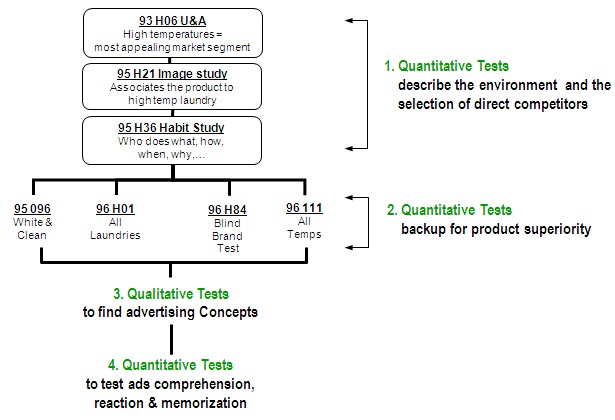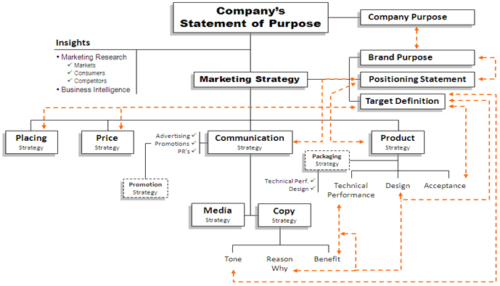The strategy plan is about how companies doing real marketing make choices and create sharp strategies meant to win in the marketplace.
This article on the strategy plan discusses the relevant strategic elements of a brand and introduces ways to think about strategies for brand building.
Strategy plan: Where we come from
A Marketing Manager asked “Do you have an example of an overall product strategy”, where by overall product strategy he meant a complete brand strategy document. In fact, most books on how to create strategies seldom show real examples from champion brands, and most available examples do not reflect how companies doing real marketing write strategies and to strategy plans.
The Brand Strategy-Plan-Tree
Brands are built on strategies, which are choices meant to assist in winning in the marketplace. Such choices encompass several brand aspects – the strategy plan of successful brands are not built on one single strategy, but rather on several different strategic choices coherent with and supportive of each other. Some of these choices are well-known and widely discussed, like the Positioning Statement and the Marketing Strategy, while others are less popular.
The following image shows the relevant brand strategies. The solid lines refer to the hierarchies and the dotted orange lines show the relationships between strategies and their elements. The Packaging and Promotion strategies are in dotted boxes because they are not always required or used.

Image 1: Brand Strategy Tree.
A short introduction to the Statement of Purpose and the Marketing Strategy follows. Then we discuss the Product Strategy in some detail.
Statement of Purpose
The company Statement of Purpose (SoP), sometimes also called Mission or Vision Statement, inspires the Marketing Strategy. For instance, P&G’s SoP says:

Such a statement sets a clear call for the brands, and is reflected in the goal of the Marketing Strategy. Read the book Built to Last, written by Collins and Porras, for a detailed discussion on how to create a sound SoP.
Marketing Strategy
The Marketing Strategy is built upon four elements: goal, brand purpose, positioning statement and target definition.
The Marketing Goal of the European extension of an iconic US laundry detergent (or Heavy Duty Detergent, HDD) brand reads:

The two key elements of any marketing goal are the What (leadership in our example) and the How (user base extension). The goal statement must be simple, measurable, achievable and challenging (SMAC). Time is not accounted for because it doesn’t make sense to constrain a brand to a predetermined time lag; the goal is not about how long you try, it is about how effectively you execute.
Brand Purpose
The Brand Purpose is an element P&G introduced recently to reinforce the purpose inspiring the brand. According to Marc Pritchard, Global Brand Building Officer at P&G, it aids in remembering that consumers[1] are people and the very goal of marketers is to make their everyday life a little bit better, because a brand isn’t a brand until it makes a difference in consumers’ lives. The Brand Purpose goes beyond the product benefit. It looks at what really motivates people and their actions, and is inspired by the company’s Purpose, which, at its best, animates movements where people advocate on your brand’s behalf.
P&G’s Purpose (do not confuse it with the Statement of Purpose) reads:

This statement is not built upon numbers, like those from surveys. It is founded in the company’s heritage and culture, and in turn it has inspired, among other P&G brands, the Brand Purpose of Tide laundry detergent:
![]()
Are you thinking that that’s an overstatement of what a laundry detergent does?
Read on, and you may change your mind.
Think of when a disaster happens, such as a hurricane destroying a city (like Katrina in New Orleans), or thousands of immigrants locked in a small area without services (like Greece and Turkey in 2017). Food, water and a place to rest are the first things people look for. In many cases the next most important thing is clean clothes because they provide dignity and normalcy. Your clothes matter because your appearance matters. Tide’s Brand Purpose helps in remembering this and inspires on how to evolve the brand in line with consumers’ lives. Does Tide’s Brand Purpose make sense now?
Positioning Statement
The Positioning Statement of [BRAND X] (which brought billions in revenues over 60+ years) reads:

It is worth noticing the benefit in the statement above is not what the product does, like removing spots or getting a whiter white, but rather what customers get: clothes looking their best. How can you get there? Go back to the product composition, then engage with surveys.
During my 20-plus years in marketing, I have read countless positioning statements, and their formal look is generally like the one above. Two things make this one different from all others: first, there are no executive elements in this statement, like Housewives 18-65 years old; and secondly, an extra page supports its execution. This extra page includes three points for [BRAND X] to support the choice of the elements of the statement. The first point reads:

The same approach is used to support the choice of “clothes looking their best”, “suitability for all temperatures” and “modern and progressive brand”. This last claim is especially important because it relates the brand to the group of people intended to buy and use it, the so-called Target Group, which in this case is different from the opposite group of “traditional and conservative” people. This distinction is of a strategic nature and fits with the strategic document. Talking about demographics, like gender and age (Housewives 18-65) is not strategic; it is an operating statement, and should be avoided within this context. The reason why is intuitively clear when we answer the question “Who is a modern and progressive person?” Not just an 18-65 year old housewife, right?
A sound target definition should indeed be based on psychographics, such as “modern and progressive”. You might be worried about the fact that people can easily be counted according to demographics, but it gets complicated when thinking of psychographic characteristics. I agree, and this is one of the reasons why marketing is a not well-understood discipline, and far too many people label themselves marketers when in fact they are not yet.
Each of the three points mentioned above is supported by the results of Marketing Research Development (MRD). The following image illustrates the brand MRD plan. The whole plan is developed in advance and each test may (and should) be repeated more than once.

Image 2: Marketing research plan of [BRAND X].
Despite the negative comments of its opponents, Marketing Research (MR) is still my best ally because marketing without reliable and unique facts and figures is just fiction. The question is not “MR yes or no?” but rather “How to make MR useful?”; the answer has to be found in your mind and technical competence.
Try LogRatio’s fully automated solution for the professional analysis of survey data.
In just a few clicks LogRatio transforms raw survey data into all the survey tables and charts you need,
including a verbal interpretation of the survey results.
It is worth giving LogRatio a try!
Strategy plan: The strategies of the marketing-mix
The Marketing Strategy inspires the strategies of the marketing-mix, among which the Communication and the Product Strategy are the most important because they are the key drivers of brand differentiation.
I won’t discuss the Distribution and Communication strategies here, the former because it is seldom a relevant differentiating factor (although it may be: think for instance of Uber vs. traditional taxi reservations), and the latter because a lot has already been written about Copy and Media strategies. Let me know, however, if you’d like to know my views about these too.
A brief discussion of the Price Strategy follows, and then the focus will be on the seldom-discussed Product Strategy.
Price Strategy
Of course price is an extremely important element for all brands and products. What I’d like to emphasize here is just the non-executive side of any strategy, to deal with the belief that the Price Strategy is about setting, well, a price. It is not.
The Price Strategy of [BRAND X] reads:

Specifying a price value is not in the scope of this strategy. Rather, it specifies how the pricing of the products belonging to a brand should be set.
[BRAND X] is clearly a leading brand in its market. The strategic statement above may, and should, change according to the competitive position your brand plays. If your product is truly innovative and offers a widely desired benefit you can aim for a premium, but these are rare cases, most often relating only to leading brands. If you are the real cost leader in a market, you can consider replacing the words “at parity with” in the above statement with “below”, but remember: There can be only one cost leader in a market, and in most cases you are not that one. So there is not much room left to orientate your pricing space. You are bound to your competitors (and there is almost always one at least, being a direct or a surrogate one), which makes setting the operating price no longer a strategic matter but rather a financial exercise. It is a different story when you talk about promotions, provided you handle them strategically.
Product Strategy
The Product Strategy isn’t discussed very often. There is a lot of talk about product innovation but, unless I follow the wrong discussions, there is less going on around how to create the Product Strategy.
An effective Product Strategy is:
-
- Created according to customer needs
- Specific and very clearly stated
- Distinctive vs. competitors
The Product Strategy of [BRAND X] reads:

In short, the Product Strategy suggests “Result X will satisfy users of product Y during usage condition Z”. The strategy encompasses three key elements:
-
- Technical performance. This is what the product does. For [BRAND X] it is superior cleaning performance. How to achieve the product performance is not an issue of strategy, it is an R&D challenge. Your duty as a marketer is to catch the attribute(s) that most appeal to your user base, and that’s a matter of market tests. Then go to the labs and create the product able to satisfy the need.
- Design. This refers to aesthetic requirements. Although products like WC Duck, the hygienic cleaner, have built their success on product (actually packaging) design, it is not a relevant attribute for all products. However, it may become a useful source of differentiation in markets where the technical performance tends to be undifferentiated – think of Smartphones as an example.
- Acceptance. This refers to the product characteristics supposed to drive customer preference against direct competitors by relating the technical performance to the customer need. For [BRAND X] it is performance superiority in the areas of whiteness/brightness for the boilwash and equal performance for the wash up to 60°C. Superiority and equality are the areas where [BRAND X] must give customers reasons to prefer it, reasons that can be measured through the voice of the customer: Marketing research.
Read (and re-read) your strategies
Your Product Strategy, like every other strategy, is created for the long term and won’t change frequently. Nevertheless, you should read it frequently, even daily, to make sure your brand develops along the specified pattern. One aspect of the brand-building process that you should have tight control over is the improvement of the overall product performance in relationship to customer needs, both articulated and unarticulated. We talk about Restaging or “Adaptive development” when improving the product performance. Restaging has three main goals:
-
- To increase market share by attracting consumer interest in your product
- To restate your product superiority against competitors
- To tailor the final product usage result to changed consumption conditions
Gillette disposable razors are a good example of restaging. Over the years they went from a meager plastic razor and a blade to double blades, blades in a cage, improved grip, lubrication, and so on to today’s five blades and Flexball for maximum contact. All of this helped Gillette secure their market leadership over time through consumer interest and product superiority. When they realized disposable razors were used by women too, they quickly adapted to the different usage conditions and brought to market a tailored product. Gillette’s funding of technology development is rooted in two beliefs: There is a better way to shave and a better way to manufacture razors, and we’ll find both of them. This is inspiring, isn’t it? Every step Gillette takes is backed up with lab and market tests. A former director at Sara Lee adapted a US Navy slogan to “In God we trust. All others bring data!” This is good advice to keep in mind when building brands and superior products.
Packaging Strategy
The product package is in some cases irrelevant while in others it can make an important contribution to reinforce the brand personality through a clearly perceived brand image. The Packaging Strategy is built around two key elements:
-
- Technical performance. It is inspired by the Positioning Statement and aims to determine the package conditions required to keep unaltered the key product characteristics. For instance: wines and oils shouldn’t be exposed to sun rays, so they need a package able to both filter the light and keep the product visible; many appliances require dent protection; and so on.
- Design. In the words of Mr. Lafley, CEO at P&G, “Good design is a catalyst for creating total experiences that transcend functional benefits and delight consumers … for moving a business from being technology-centered or product-myopic to one that is more consumer-experience-centric. From the consumer’s point of view, design is about form and function, about emotion and experience”. Design strengthens the brand personality, and it is developed according to the Copy Strategy. As with all other strategies, this one too doesn’t include any executive elements, such as colors, size, materials, etc. I suspect that in the future, due to the increasing difficulty in finding innovative product performance, the importance of package design to differentiate brands from competitors will grow.
Although the choices driving the Packaging Strategy may vary broadly from market to market, the following characteristics may be generalized to a wide range of products:
-
- Ease, safety and comfort. These characteristics may contribute substantially to reinforce brand image and product preference. The most effective ones are those not easily copied, for instance those that are patent protected or derive from complex production processes. The ergonomic shapes of mineral waters, for instance, have eased product usage by making them easier to grip (think for instance of people with a weak handgrip). Certain pharmaceutical drugs require safety caps to prevent children to open them. Separately packed women’s diapers add to user comfort, where comfort is not a physical condition but rather a mental state.
- To communicate and promote. Many small on-shelf products wear huge packagings. This approach makes the product more visible, which helps to promote it, giving it a presence to communicate with shoppers.
- Search for uniqueness. As already mentioned, WC Duck is one of the best examples of enduring packaging design providing product uniqueness. Thanks to design, Febreze air-freshener improved its shelf visibility and communicated its benefit better (air freshening vs. odor masking). Nike replaced the old shoebox of their Air sneakers with a terrific packaging design (an air-tight plastic bag to give the illusion of floating trainers) totally in line with the product benefit. And the list of products made unique by package design can go on and on. When you do not have a strong, unique benefit, design is one of your best allies.
_______________________________________
[1] We use the word „consumer“ throughout this article with the meaning of both “user” and/or “buyer”.

